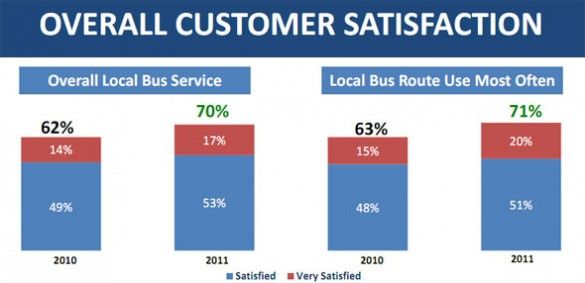Bus Satisfaction Survey Results 2011

THE COMMUTE: Yesterday, I discussed at length the faulty methodology used by the MTA in its Customer Service Bus Satisfaction Survey. Today, I will interpret what the results are really saying.
The Service Results (Comments in Italics)
- Overall Local Service – 70 percent satisfied. Limited and Select Bus Service are included in this number.
- Overall Service Availability – 68 percent satisfied.
- Frequency of Service – 65 percent satisfied.
- Bus Wait Times – 58 percent satisfied. Notice how low this number is as compared to the others. In other words, 42 percent of the riders believe they have to wait too long for a bus. If the sample could be broken down by route or time period, the number of dissatisfied riders for lightly-serviced routes would be much higher.
- Bus Service Reliability – 77 percent satisfied. Poor question since it does not ask the respondent to exclude maintenance in their definition of service reliability. Maintenance satisfaction is a separate question and is rated highly.
- Predictability of Travel Times – 73 percent satisfied. This only shows that riders can fairly accurately predict where their buses will get stuck in traffic or that they will have to wait longer than they should for a bus and also factor those variables into their travel time predictions.
- How fast the bus gets you places – 81 percent satisfied. Now here is an interesting question: If 81 percent of local bus riders are satisfied with how fast they can get places, why is the MTA going ahead with its Select Bus Service (SBS) initiative if not only to reduce operating costs? When stating the case for SBS, the MTA claimed bus riders are generally unhappy with slow bus speeds and that is their primary motivation for moving forward with the project. You can’t have it both ways. Either local buses are fast or too slow, not both.
- Convenience of Bus Routes – 87 percent satisfied. This one is easy to explain. Those who feel the routes are not convenient are not riding the bus and therefore not included in the survey. (They are using the dollar vans, walking, or making longer trips on the subway to reach their destinations. See also yesterday’s column under “Missing Questions.)
- Ease of Making Travel Connections. – 86 percent. Since only 58 percent are satisfied with bus wait times, we can either conclude that most connections are to the subway, or wait time is not considered by the respondents in answering this question and instead they are only considering proximity between transferring bus stops and subways stations.
In conclusion, the MTA is not honest and cannot be trusted. They first draw their conclusions, then pick and choose the data they want to show to back up those conclusions. In this case the MTA wanted to show that a majority of riders are content with the service they provide.
The biased nature of this survey is no different from the way the MTA declared last year’s service cutbacks a success although the data suggested otherwise; the way they slanted the facts when minimizing the disadvantages of the service cutbacks; or the way they withheld information regarding the proposed B44 Select Bus Service, for example, that through traffic will share a single lane with those waiting to make a left turn south of Avenue X when the exclusive lane is in effect.
As I stated, half the time your local bus trip will go smoothly. Even with the all the built in biases, 42 percent of those surveyed believed they have to wait too long for a bus. Pleasing more than half the people should not be the standard for doing a good job. There are very serious problems with local buses and those need to be addressed.
This survey makes it appear that the only problems facing bus riders are not knowing when the next bus will arrive and the need to increase bus speeds although 81 percent of the people are already satisfied with bus speeds, as the MTA also claims. It is no coincidence that they are addressing both these issues.
Other serious problems like the need to update routes that have needed change for over 50 years to better serve major institutions like Maimonides Hospital or fairly recent land-use changes like the development of the Spring Creek Gateway Regional Shopping Center are ignored. Accessing Gateway is at least a 90-minute trip from Sheepshead Bay requiring double fare for most, while only a 20-minute trip by car most of the time. The survey provides a convenient excuse not to address problems like routing issues and the need to minimize bus bunching.
The Commute is a weekly feature highlighting news and information about the city’s mass transit system and transportation infrastructure. It is written by Allan Rosen, a Manhattan Beach resident and former Director of MTA/NYC Transit Bus Planning (1981).




